The AMD Zen and Ryzen 7 Review: A Deep Dive on 1800X, 1700X and 1700
by Ian Cutress on March 2, 2017 9:00 AM ESTBenchmarking Performance: CPU Rendering Tests
Rendering tests are a long-time favorite of reviewers and benchmarkers, as the code used by rendering packages is usually highly optimized to squeeze every little bit of performance out. Sometimes rendering programs end up being heavily memory dependent as well - when you have that many threads flying about with a ton of data, having low latency memory can be key to everything. Here we take a few of the usual rendering packages under Windows 10, as well as a few new interesting benchmarks.
Corona 1.3
Corona is a standalone package designed to assist software like 3ds Max and Maya with photorealism via ray tracing. It's simple - shoot rays, get pixels. OK, it's more complicated than that, but the benchmark renders a fixed scene six times and offers results in terms of time and rays per second. The official benchmark tables list user submitted results in terms of time, however I feel rays per second is a better metric (in general, scores where higher is better seem to be easier to explain anyway). Corona likes to pile on the threads, so the results end up being very staggered based on thread count.
Blender 2.78
For a render that has been around for what seems like ages, Blender is still a highly popular tool. We managed to wrap up a standard workload into the February 5 nightly build of Blender and measure the time it takes to render the first frame of the scene. Being one of the bigger open source tools out there, it means both AMD and Intel work actively to help improve the codebase, for better or for worse on their own/each other's microarchitecture.
LuxMark
As a synthetic, LuxMark might come across as somewhat arbitrary as a renderer, given that it's mainly used to test GPUs, but it does offer both an OpenCL and a standard C++ mode. In this instance, aside from seeing the comparison in each coding mode for cores and IPC, we also get to see the difference in performance moving from a C++ based code-stack to an OpenCL one with a CPU as the main host.
POV-Ray 3.7
Another regular benchmark in most suites, POV-Ray is another ray-tracer but has been around for many years. It just so happens that during the run up to AMD's Ryzen launch, the code base started to get active again with developers making changes to the code and pushing out updates. Our version and benchmarking started just before that was happening, but given time we will see where the POV-Ray code ends up and adjust in due course.
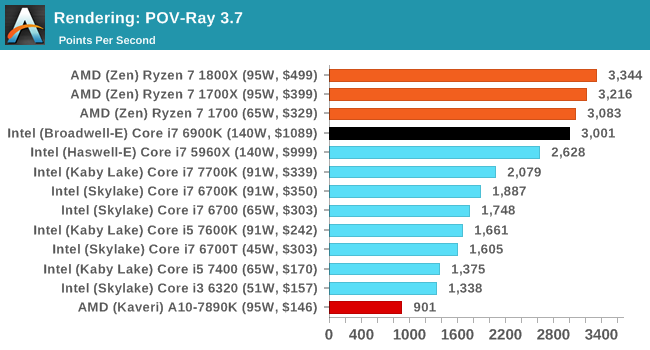
Cinebench R15
The latest version of CineBench has also become one of those 'used everywhere' benchmarks, particularly as an indicator of single thread performance. High IPC and high frequency gives performance in ST, whereas having good scaling and many cores is where the MT test wins out.
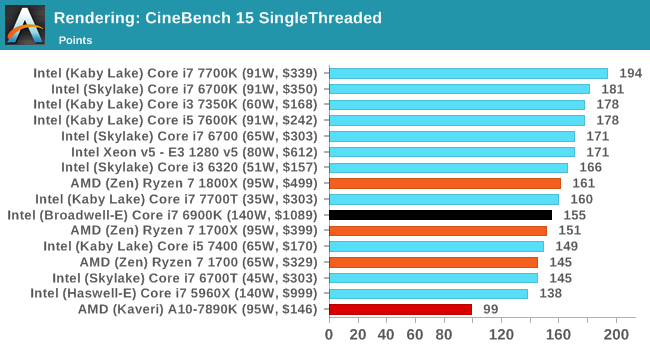
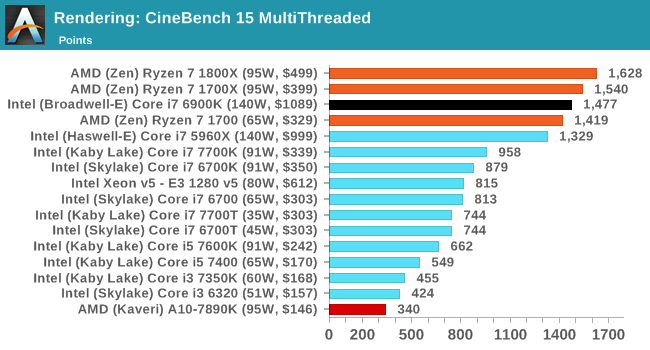


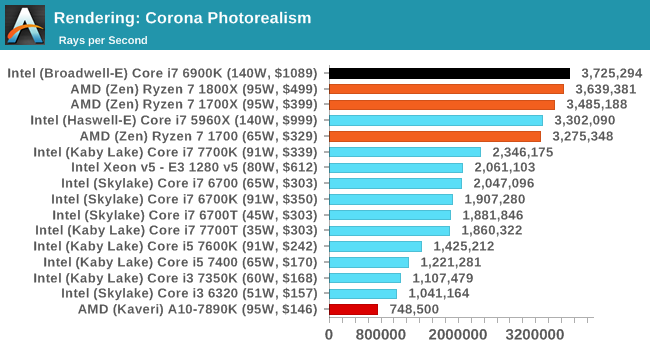
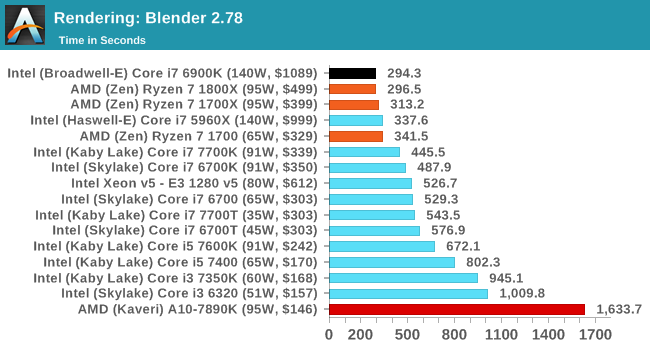

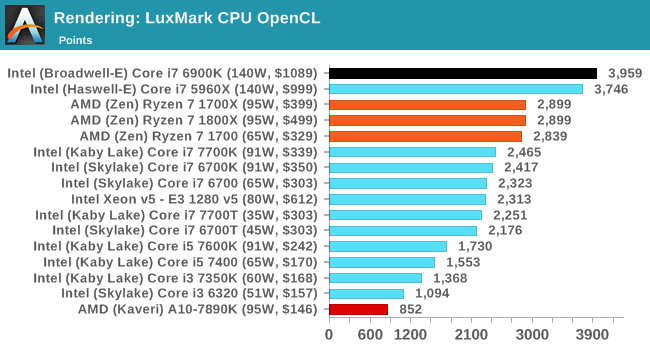








574 Comments
View All Comments
zangheiv - Thursday, March 2, 2017 - link
Hard to believe how a company like intel that repeatedly and knowingly engaged in illegal acts and other tactics to monopolize the market and cheat the consumers into high-prices, can still have dumb happy consumers after Ryzenlmcd - Thursday, March 2, 2017 - link
Some people like 256-bit vector ops I guess :-/ who would've guessed?Ratman6161 - Thursday, March 2, 2017 - link
Have to agree. To me, the i7-7700K seems like the better bargain right now. Then again, I'm looking at a $329 I7-6700K motherboard and CPU bundle and the 7700K isn't really all that much of an upgrade from the 6700K. But in the final analysis, after all this reading, I'm still not seeing anything that makes me want to rush out and replace my trusty old i7-2600K.Meteor2 - Friday, March 3, 2017 - link
+1. Maybe, as Rarson says above, a 4C/8T Zen might clock fast enough to challenge the 7700K. But in the workloads run at home, the 1800X does not challenge the (cheaper) 7700K.HPC and data centre are completely different and here Zen looks like it has real promise.
Meteor2 - Friday, March 3, 2017 - link
...Sadly the R5s are clocked equally low.https://www.google.co.uk/amp/wccftech.com/amd-ryze...
Limited by process, I guess.
Cooe - Sunday, February 28, 2021 - link
Again. You're an absolute idiot for thinking that the only "workloads done at home" are 1080p gaming & browsing the web.... You are so out of touch with the desktop PC market, it's almost unbelievable. Here's hoping you were able to aquire some common sense over the past 4 years.cmdrdredd - Saturday, March 4, 2017 - link
" I'm still not seeing anything that makes me want to rush out and replace my trusty old i7-2600K."I agree with you. I have an overclocked 3570k and I don't see anything that makes me feel like it's too old. I'm mostly gaming on my system when I use it heavily, otherwise it's just general internet putzing around
Jimster480 - Thursday, March 2, 2017 - link
Sorry but this is not the case.This is competing against Intel's HEDT line and not against the 7700k.
2011v3 offers more PCI-E lanes only if you buy the top end CPU (which ofc isn't noted in most places) a cheaper chip like the 5820k for example only offers like 24 lanes TOTAL. Meaning that in price comparison there is no actual comparison.
Ratman6161 - Thursday, March 2, 2017 - link
Well, whomever is trying to compete against, I7-7700K is about the top of the price range I am willing to spend. So Intel's 2011V3 lineup isn't in the cards for me either. AMD really isn't offering anything much for the mid range or regular desktop user either. In web browsing, office tasks, etc, their $499 CPU is often beaten by an i3. Now, the i3 is just as good as an i7-6900K too and in at least one test the i3 7350K is top of the charts. Why does this matter? Well, where does AMD go from here? If the i3 out performs the 1800x for office tasks, what will happen when they cut it to 4 cores to make a cheaper variant? Seems like they are set up for very expensive CPU's and for CPU's they have to sell for next to nothing. Where will their mid range come from?silverblue - Thursday, March 2, 2017 - link
Something tells me that if I decide to work on something complicated in Excel, that i3 isn't going to come anywhere near an R7. Besides, the 4- and 6-core variants may end up clocked higher, we don't know for sure yet.